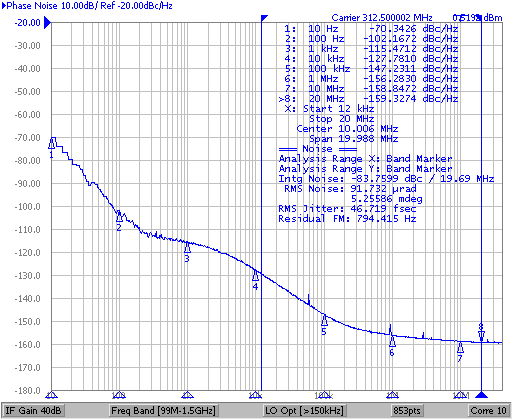ZHCSID6A December 2018 – December 2018 LMK05318
PRODUCTION DATA.
- 1 特性
- 2 应用
- 3 说明
- 4 修订历史记录
- 5 (说明 (续))
- 6 Pin Configuration and Functions
- 7 Specifications
- 8 Parameter Measurement Information
-
9 Detailed Description
- 9.1 Overview
- 9.2 Functional Block Diagram
- 9.3
Feature Description
- 9.3.1 Oscillator Input (XO_P/N)
- 9.3.2 Reference Inputs (PRIREF_P/N and SECREF_P/N)
- 9.3.3 Clock Input Interfacing and Termination
- 9.3.4 Reference Input Mux Selection
- 9.3.5 Hitless Switching
- 9.3.6 Gapped Clock Support on Reference Inputs
- 9.3.7 Input Clock and PLL Monitoring, Status, and Interrupts
- 9.3.8
PLL Relationships
- 9.3.8.1 PLL Frequency Relationships
- 9.3.8.2 Analog PLLs (APLL1, APLL2)
- 9.3.8.3 APLL Reference Paths
- 9.3.8.4 APLL Phase Frequency Detector (PFD) and Charge Pump
- 9.3.8.5 APLL Feedback Divider Paths
- 9.3.8.6 APLL Loop Filters (LF1, LF2)
- 9.3.8.7 APLL Voltage Controlled Oscillators (VCO1, VCO2)
- 9.3.8.8 APLL VCO Clock Distribution Paths (P1, P2)
- 9.3.8.9 DPLL Reference (R) Divider Paths
- 9.3.8.10 DPLL Time-to-Digital Converter (TDC)
- 9.3.8.11 DPLL Loop Filter (DLF)
- 9.3.8.12 DPLL Feedback (FB) Divider Path
- 9.3.9 Output Clock Distribution
- 9.3.10 Output Channel Muxes
- 9.3.11 Output Dividers (OD)
- 9.3.12 Clock Outputs (OUTx_P/N)
- 9.3.13 Glitchless Output Clock Start-Up
- 9.3.14 Clock Output Interfacing and Termination
- 9.3.15 Output Synchronization (SYNC)
- 9.3.16 Zero-Delay Mode (ZDM) Synchronization for 1-PPS Input and Output
- 9.4 Device Functional Modes
- 9.5 Programming
- 10Application and Implementation
- 11Power Supply Recommendations
- 12Layout
- 13器件和文档支持
- 14机械、封装和可订购信息
5 (说明 (续))
DPLL 支持抖动和漂移衰减的可编程环路带宽,而两个 APLL 支持分频率转换,从而可以实现灵活的时钟生成。DPLL 上支持的同步选项包括采用相位消除的无中断切换、数字保持和频率阶跃小于 0.001ppb(十亿分之一)的 DCO 模式,从而实现精确的时钟控制(IEEE 1588 PTP 从运行)。DPLL 可以锁相到 1 PPS(每秒脉冲数)基准输入,并且在一个输出上支持可选零延迟模式,以实现具有可编程失调电压的确定性输入到输出相位校准。先进的基准输入监控块可确保稳健的时钟故障检测并在发生基准缺失 (LOR) 时帮助将输出时钟干扰降至最低。
该器件可以使用通用的低频 TCXO 或 OCXO 来根据同步标准设置自由运行型或保持型输出频率稳定性。否则,在自由运行型或保持型频率稳定性和漂移不重要时,该器件可以使用标准 XO。该器件可通过 I2C 或 SPI 接口实现完全编程,在通电后支持通过内部 EEPROM 或 ROM 进行自定义频率配置。EEPROM 在出厂时进行了预编程,且可根据需要进行系统内编程。
